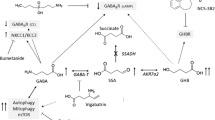Abstract
Summary: In vitro studies suggest that excitotoxic cell damage is an underlying mechanism for the acute striatal damage in glutaryl-CoA dehydrogenase (GCDH) deficiency. It is believed to result from an imbalance of glutamatergic and GABAergic neurotransmission induced by the accumulating organic acids 3-hydroxyglutaric acid (3-OH-GA) and to a lesser extent glutaric acid (GA). Stereotaxic administration of 3-OH-GA and GA into the rat striatum have confirmed these results, but may not truly represent the effect of chronic exposure to these compounds. In an attempt to better understand the pathophysiology of GCDH deficiency in vivo, two animal models have been utilized. A mouse that lacks GCDH activity in all tissues was generated by gene targeting in embryonic stem cells. These animals develop the characteristic biochemical phenotype of the human disease. Pathologically, these mice have a diffuse spongiform myelinopathy similar to that in human patients; however, there is no evidence for acute striatal damage or sensitivity to acute encephalopathy induced by catabolism or inflammatory cytokines. A naturally occurring animal model, the fruit-eating bat Rousettus aegypticus, lacks hepatic and renal GCDH activity, but retains cerebral enzyme activity. Like the mouse, these bats develop the characteristic biochemical phenotype of glutaryl-CoA dehydrogenase deficiency, but lack overt neurological symptoms such as dystonia. It is not known whether they also develop the spongiform myelinopathy seen in the Gcdh-deficient mice. Otherwise, these constellations would suggest that cerebral GCDH deficiency is responsible for the development of neuronal damage. The lack of striatal damage in these two rodent models may also be related to species differences. However, they also highlight our lack of a comprehensive understanding of additional factors that might modulate the susceptibiliy of neurons to accumulating 3-OH-GA and GA in GCDH deficiency. Unravelling these mechanisms may be the key to understanding the pathophysiology of this unique disease and to the development of neuroprotective strategies.
Similar content being viewed by others
REFERENCES
Bähr O, Mader I, Zschocke J,et al (2002)Adult onset glutaric aciduria type I presenting with leukoencephalopathy.Neurology 59:1802-1804.
Beal MF, Brouillet E, Jenkins B, Henshaw R, Rosen B, Hyman BT (1993)Age-dependent striatal excitotoxic lesions produced by the endogenous mitochondrial inhibitor malonate. J Neurochem 61:1147-1150.
Bennett MJ, Marlow N, Pollitt RJ, Wales JKH (1986)Glutaric aciduria type I:biochemical investigations and post mortem findings.Eur J Pediatr 145:403-405.
Calabresi P, Centonze D, Pisani A (1998)Striatal spiny neurons and cholinergic interneurons express differential ionotropic glutamat rgic responses and vulnerability:implications for ischemia and Huntington disease.Ann Neurol 43:586-597.
Chow CW, Haan EA, Goodman SI,et al (1988)Neuropathology of glutaric acidaemia type I.Acta Neuropathol 76:590-594.
de Mello CF, Begnini J, Jiménez-Bernal RE,et al (1996)Intrastriatal methylmalonic acid administration induces rotational behavior and convulsions through glutamatergic mechanisms.Brain Res 721:120-125.
de Mello CF, Kölker S, Ahlemeyer B,et al (2001)Intrastriatal administration of 3-hydroxyglutaric acid induces convulsions and xcitotoxic l sions in rats.Brain Res 916: 70-75.
Goodman SI, Norenberg MD, Shikes RH,t al (1977)Glutaric aciduria:biochemical and morphological considerations. J Pediatr 90:746-750.
Koeller DM, DiGuilio KA, Angeloni SV,et al (1995)Cloning,structure,and chromosome localization of the mouse glutaryl-CoA dehydrogenase gene.Genomics 28:508-512.
Koeller DM, Woontner M, Crnic LS,et al (2002)Biochemical,pathologic and behavioral analysis of a mous mod l of glutaric acidemia type I. Hum Mol Genet 11:347-357.
Kölker S, Ahlemeyer B, Krieglstein J, Hoffmann GF (2001)Contribution of reactive oxygen species to 3-hydroxyglutarate neurotoxicity in primary neuronal cultures from chick mbryo telencephalons.Pediatr Res 50:76-82.
Kölker S, Mayatepek E, Hoffmann GF (2002)White matter disease in cerebral organic acid disorders:clinical implications and suggested pathom chanisms.Neuropediatrics 33: 225-231.
Kölker S, Schor DSM, Feyh P,et al (2003)Glutaryl-CoA dehydrogenase deficiency: region-specific analysis of organic acids and acylcarnitin s in post mort m brain predicts vulnerability of the putamen.Neuropediatrics 34:253-260.
Kölker S, Koeller DM, Sauer S,et al (2004)Excitotoxicity and bioenerg tics in glutaryl-CoA dehydrogenas deficiency. J Inherit Metab Dis 27:805-812.
Land JM, Goulder P, Johnson A, Hockaday J (1992)Glutaric aciduria type 1:an atypical presentation together with some observations upon treatment and the possible cause of cerebral damage.Neuropediatrics 23:322-326.
Latini A, Borba Rosa R, Scussiato K,et al (2002)3-Hydroxyglutaric acid induces oxidative stress and decreases the antioxidant defenses in cerebral cortex of young rats. Brain Res 956:367-373.
Leibel RL, Shih VE, Goodman SI,et al (1980)Glutaric acidemia:a metabolic disorder causing progressive choreoathethosis. Neurology 30:1163-1168.
Lima TTF, Begnini J, de Bastiani J,et al (1998)Pharmacological evidence for GABAergic and glutamatergic involvement in the convulsant and behavioral effects of glutaric acid.Brain Res 802:55-60.
McMillan TA, Gibson KM, Sweetman L, Meyers GS, Green R(1988)Conservation of central nervous system glutaryl-coenzyme A d hydrog nase in fruit-eating bats with glutaric aciduria and deficient hepatic glutaryl-coenzyme A dehydrog nase.J Biol Chem 263: 17258-17261.
Nishino H, Shimano Y, Kumazaki M, Sakurai T (1995)Chronically administered 3-nitropropionic acid induces striatal lesions attributed to dysfunction of the blood-brain barrier. Neurosci Lett 186:161-164.
Porciuncula LO, Dal-Pizzol A, Coitinho AS,et al (2000)Inhibition of synaptosomal [3 H ]glutamat uptak and [3 H ]glutamat binding to plasma m mbranes from brain of young rats by glutaric acid in vitro.J Neurol Sci 173:93-96.
Soffer D, Amir N, Elpeleg ON,et al (1992)Striatal degeneration and spongy my linopathy in glutaric acid mia.J Neurol Sci 107:199-204.
Stokke O, Goodman SI, Moe PG (1976)Inhibition of brain glutamat decarboxylase by glutarate,glutaconat, and β-hydroxyglutarate:explanation of the symptoms in glutaric aciduria?Clin Chim Acta 66:411-415.
Strauss KA, Morton DH (2003)Type I glutaric aciduria,part 2:A model of acute striatal necrosis.Am J Med Genet 121C:53-70.
Ullrich K, Flott-Rahmel B, Schluff P,et al (1999).Glutaric aciduria typ I:pathom chanism of neurodegeneration.J Inherit Metab Dis 22:392-403.
Woontner M, Crnic LS, Koeller DM (2000)Analysis of the expression of murine glutaryl-CoA dehydrogenase:in vitro and in vivo studies. Mol Genet Metab 69:116-122.
Author information
Authors and Affiliations
Corresponding author
Rights and permissions
About this article
Cite this article
Koeller, D.M., Sauer, S., Wajner, M. et al. Animal models for glutaryl-CoA dehydrogenase deficiency. J Inherit Metab Dis 27, 813–818 (2004). https://doi.org/10.1023/B:BOLI.0000045763.52907.5e
Issue Date:
DOI: https://doi.org/10.1023/B:BOLI.0000045763.52907.5e




